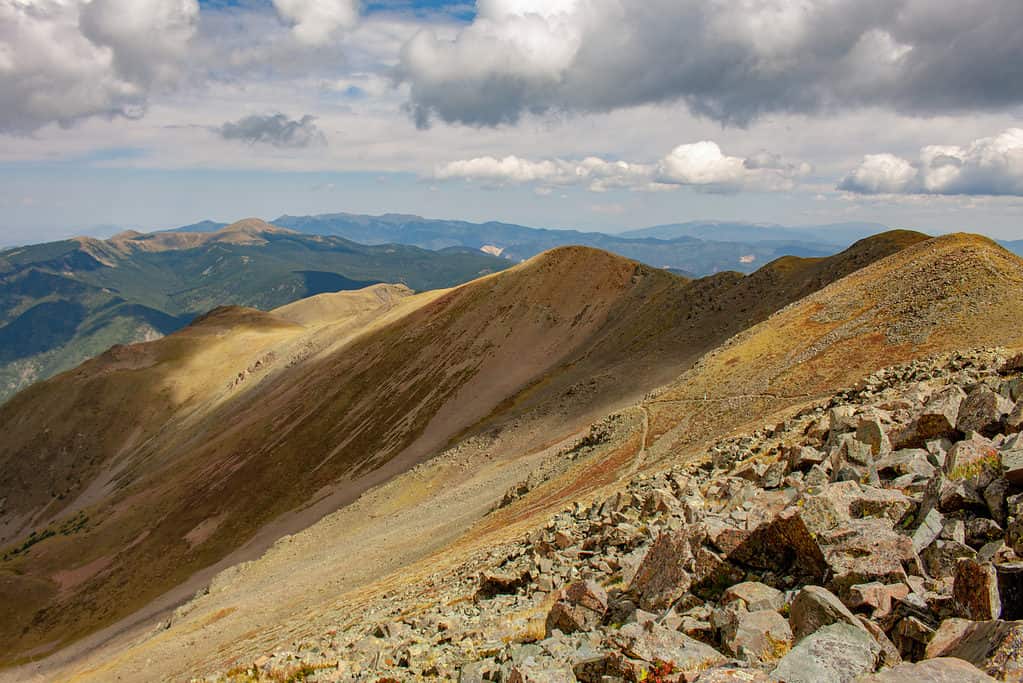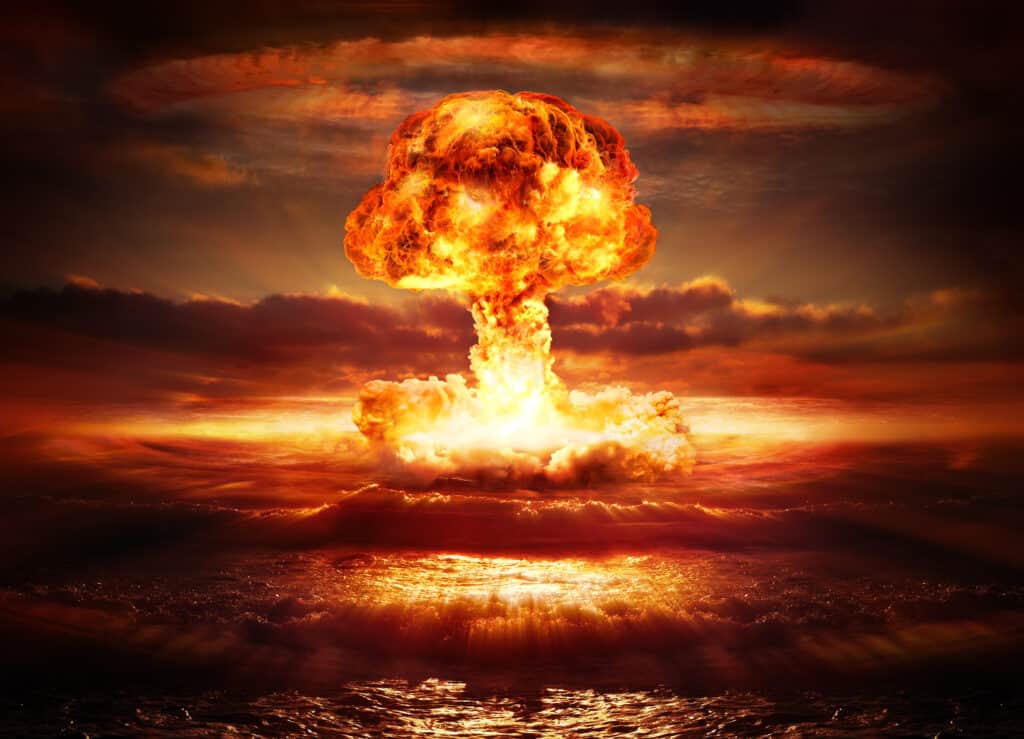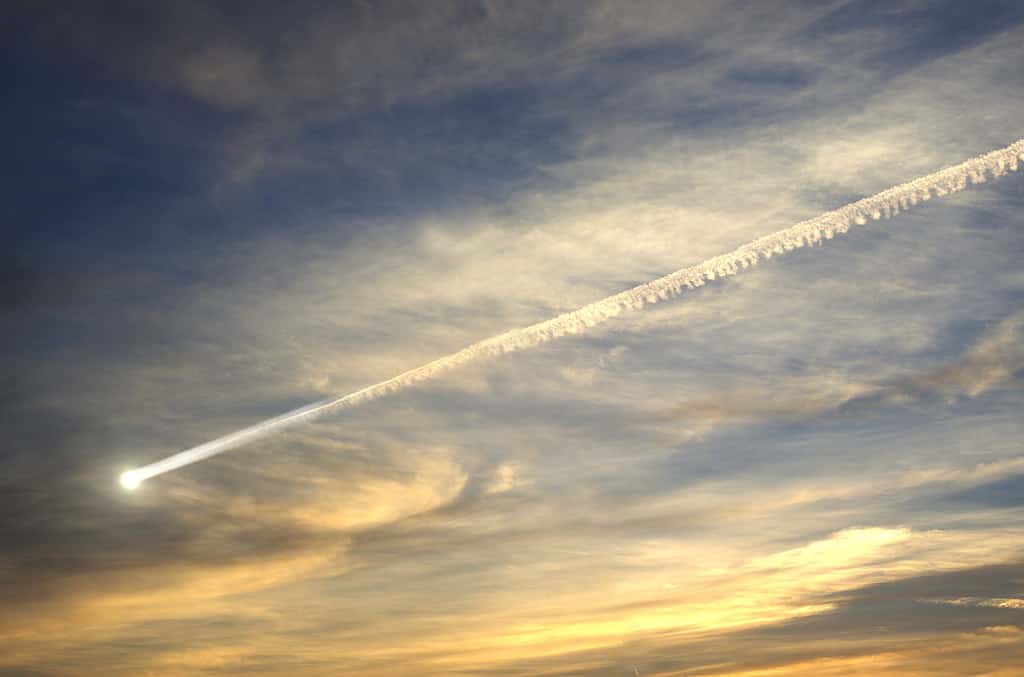New Mexico can seem at times like another world, with its dry, rocky landscape and numerous craters. Most of its craters were made by volcanoes.
Vulcanologists and geologists consider the state a kind of museum or laboratory. It has the largest number, age, and diversity of volcanic types in North America.
But what about impact craters?
New Mexico has those as well, though you might have to look a little harder to find them. And the biggest impact crater in New Mexico might be especially hard to find.
In fact, it’s not even called a crater, but an “impact structure.” Read on to find out more!

The Santa Fe impact structure is in the Sangre de Cristo mountains of New Mexico.
©iStock.com/Raisa Nastukova
The Biggest Impact Crater in New Mexico
It’s clear from the overlapping craters on our Moon that our solar system went through heavy bombardment in the past. Because the Moon has no weather, tectonic activity, glaciation, or vegetation, its craters are extremely well-preserved. Earth itself has no doubt had just as many impacts. However, our craters have been worn down and are not so obvious. Such is the case with the biggest impact crater in New Mexico.
The Santa Fe impact structure is located in the Sangre de Cristo Mountains to the northeast of Santa Fe. Geologists believe it was created between 1.4 and 1.6 billion years ago – so ancient that it has eroded almost completely away, leaving only its deepest layers to be studied today. Those layers, though, include shatter cones, an undeniable marker of extreme shock pressure that can only be formed in a meteor impact or a nuclear explosion. A road cut in 2005 exposed some of these shatter cones and tipped off geologists to the presence of the ancient crater.

Both the Earth and its Moon have been bombarded by many thousands of meteorites, but the evidence has generally been eroded away.
©NASA (image by Lunar Reconnaissance Orbiter) / public domain – License
What Caused the Biggest Impact Crater in New Mexico?
Geologists studying the different geological strata of the earth in the area understood that the impact damage had happened in Precambrian rock dated to 1.4 to 1.6 billion years ago. To be honest, we don’t know very much about this extremely ancient period, even though the term “Precambrian” is used to cover about 8/10ths of the planet’s whole history! All life is wonderfully complex, but what existed at that time were mainly microscopic organisms that seem simple in comparison to the more advanced kinds of plants and animals that came about later and seemed to diversify and expand very quickly, on a geologic timescale.
There are also a lot of variables in meteor impacts that leave uncertainties about the explosion. Generally speaking, a larger object will cause a larger explosion, but it also depends on what it is made of. Is it made of nickel and iron, or softer materials such as loosely packed ice, rocks, and dust like a cometary nucleus?
Additionally, the speed and angle of the object’s entry into the atmosphere helps to determine how much of it survives long enough to explode. And it also makes a difference where it explodes: in the air, in water, or on land. A lot of those variables are unknown. However, what we can be sure about is this: Any explosion big enough to leave behind evidence a billion years later, would have been stronger than the combined force of all our nuclear weapons today. It would have been an explosion on a scale that could make species go extinct – even our own.

The biggest impact crater in New Mexico was formed in a titanic explosion far larger than the largest nuclear explosion ever created by humanity.
©Romolo Tavani/Shutterstock.com
What Lived in New Mexico at the Time of Impact?
When geologists first named the various geologic strata, they thought that all life began on Earth in the Cambrian area. “Precambrian” was a really broad term just to cover eons of lifeless geologic history that wasn’t understood that well. Over many decades of detailed research, though, scientists know now that life dates back a lot earlier than anyone could have imagined. Deep drilling in places like the Kola Superdeep Borehole helped confirm that the origin of life goes back at least 3.5 billion years.
The types of living things in New Mexico when the meteor struck may have been things like algae-like plants, flagellates, and stromatolites (sheet-like mats of microorganisms). But it would still be another billion years or more before the so-called “Cambrian explosion” – a period of time when life seemed to take a leap forward in complexity and diversity after what appeared to be eons of slow development.

Cyanobacteria is one of the earliest forms of life to evolve on Earth. It is one of the species that lived in the Precambrian era.
©VectorMine/Shutterstock.com
Could It Happen Again?
Every day, many tons of debris from space filter down to the surface of the Earth. Most of it is small and burns up in the atmosphere as it heats from friction with air molecules. On just about any night, you can see what we commonly call “shooting stars” or “fireballs.” And sometimes those can be frighteningly large, like the meteor that lit up the sky over Kyiv, Ukraine in 2023. Rarely, meteors survive to impact the surface. But the truly large ones only happen in time intervals of thousands of years.
NASA and other space agencies have programs to map and track dangerous objects in space. One that makes the news every so often is Apophis, an asteroid about 1,200 feet in diameter. This guy orbits the Sun in a way that takes it uncomfortably close to Earth every few decades. Astronomers say it will not hit the planet for at least the next 100 years, but they’re remaining aware. NASA has already completed a mission that used a rocket collision to change the orbit of a small asteroid. As this technology grows more advanced, it might allow us to “corral” asteroids with valuable minerals. In this way, we could position them into near-Earth orbits that would let us mine them for raw materials.

Most meteors burn up in the Earth’s atmosphere without ever hitting the ground. They’re colloquially called “fireballs” or “shooting stars.”
©Krasowit/Shutterstock.com
What Are the Chances?
So, just how much sleep should you lose over the possibility of being killed by a meteor? Not very much. Here’s the reality – the actual chances of getting killed by a meteor are about 1 in 250,000. The chances of getting killed in a plane crash are 1 in 30,000. And the chances of winning the PowerBall are about 1 in 195,000,000. So, odds are, none of those things are going to happen. What is much more likely to happen is that you don’t eat healthy, forget to exercise, fall down some stairs, or crash your car. For most of us, those are the real life-threatening dangers.
But if you’re still just an ever-so-little-bit worried, just remember that 2/3 of the surface of our planet is water. Of the remaining portion, half is covered in uninhabited ice sheets, mountains, deserts, or deep forests. So, unless you live off the grid, your odds of avoiding interacting with a meteor just got a whole lot better.
Where is The Santa Fe Impact Located on a Map?
The Santa Fe impact structure refers to a weathered remains of a crater formed by the impact of a large celestial body, known as a bolide, in the Sangre de Cristo Mountains located northeast of Santa Fe, New Mexico.
Here is The Santa Fe impact on a map:
The photo featured at the top of this post is © Triff/Shutterstock.com
Thank you for reading! Have some feedback for us? Contact the AZ Animals editorial team.






